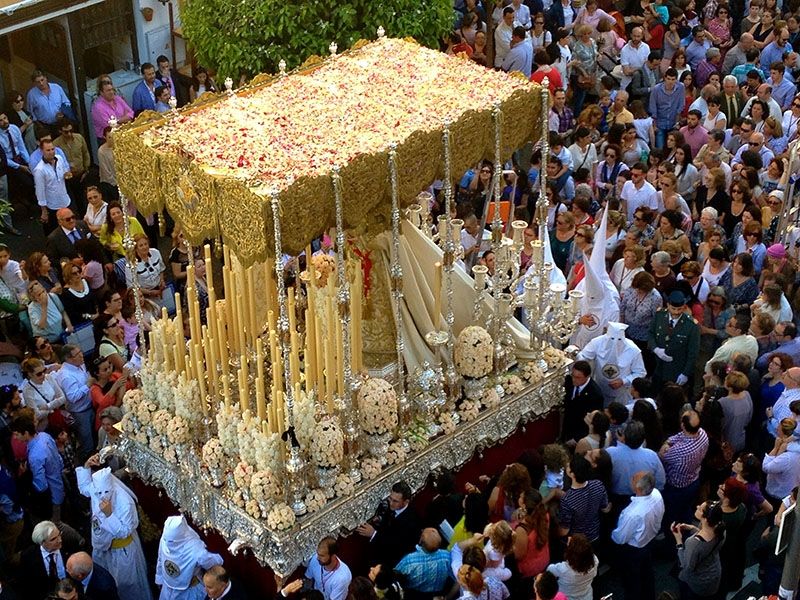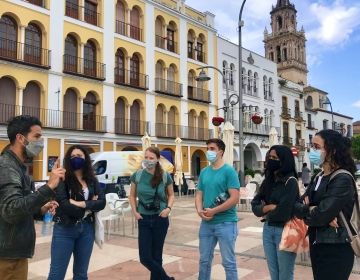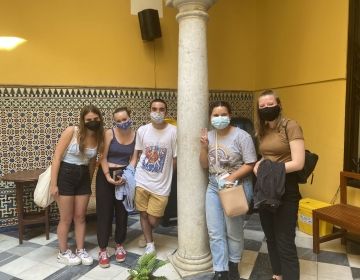La Semana Santa
Semana Santa was an absolutely unbelievable experience. I, unfortunately, was only there for two days, but even that was enough to see how amazing the whole week is. Technically, it's a religious holiday, but in practice, tradition and culture are equally important. The story I heard was that Semana Santa started originally after a plague a really long time ago (oops don't remember the year) wiped out a large percentage of the population, so people started to lose faith in God/the church. As a result, the church began La Semana Santa as a way to regain popularity. So obviously, it was a religious thing. It's also something that's celebrated all over the world, mostly in Spanish speaking countries. I think in Latin-American countries it's a little different, but all over Spain it's roughly the same, in format at least: all week long, there are different "cofradías" or "hermandades" ("brotherhoods", which are the religious organizations that belong to the churches) that bring their "pasos" (kind of like big parade floats but with statues of Jesus or Mary or other religious figures) around the city. These pasos are carried by a group of men called "costaleros". Most cofradías have a paso of Jesus, followed by a paso of Mary, which is usually the more important one. One whole cofradía can take hours to pass one spot because there are anywhere from hundreds to thousands of "nazarenos", which are the scary looking people in white hoods in the pictures, as well as "penitentes", which are the cross-carrying people without the pointy hood, and a band that follows the paso. The pasos usually start after lunch (3 or 4) and go until 3 or 4 the next morning-- so people who are in the cofradía as nazarenos or penitentes or costaleros are walking for 12 to 14 hour usually. CRAZY. Some of the cofradías are stricter and you're not allowed to eat or drink or talk or anything when you're marching, but the majority unofficially allow people to eat/drink/leave if they need to go to the bathroom or something. A lot of kids march as nazarenos so they obviously don't usually go for all 14 hours. And so all of the pasos leave from their churches and go to the official section of their march, which is in the center by the Giralda and what not, and then they head back to their church. Some take longer because they live farther; some are closer. Ok so that's the basic idea. My favorite paso to see was La Estrella, one that comes from a church in Triana, because we saw it on its "recogida" (on its way back into the church) at night while it was crossing the Triana Bridge. La recogida is usually the best time to see the cofradía because they're not on a time frame (like they are in the official section) so they do all kinds of cool stuff and the costaleros do cool things to make the pasos move in different ways. It was so impressive to see the paso, lit up with candles and shining and beautiful, surrounded by thousands of people, crossing the equally beautiful Triana bridge at night. It was one of those things that's just indescribable but gives you goose bumps and you sort of forget to breath for a second. We also saw a "saeta" with La Estrella, which is person who sings this specific kind of flamenco called saeta. Some of them are official and paid and some are spontaneous. The one we saw was spontaneous and it was so cool cause he was just standing in the crowd looking up at the paso and singing and AH so cool. Ok, now for pictures.














My camera very sadly died after this, so I don't have pictures of the night on the bridge.






More than anything, I can't thank Lucia enough for giving me the experience that I had. Although Semana Santa would be super impressive to anyone, it's best when you get to follow someone around who knows where to go, when to go, and how to explain all that's happening.
OK cool so that's Semana Santa. Thx for making it through with me. While writing this post over the last couple days I've managed to edit the Ireland pictures, but still working on Budapest. So that will be coming up soon. Xo
Related Posts
GAP & HSA: palaces & gastronomy in Écija & Osuna, Sevilla
Our GAP and HSA students got to visit these wonderful towns before they departed back to the States. Ecija is known as the City of Towers. Located in the centre... keep reading
It´s not goodbye, it´s hasta luego
Our GAP program ended last week and althought we are sad to see our participants go, we are extremelly happy to have been able to offer a program that offers... keep reading
Exploring medieval castles in Sevilla
Our GAP students got the opportunity to explore two of the most important towns in the province of Seville: Alcalá de Guadaira and Utrera. Alcalá’s castle is the result of... keep reading
















